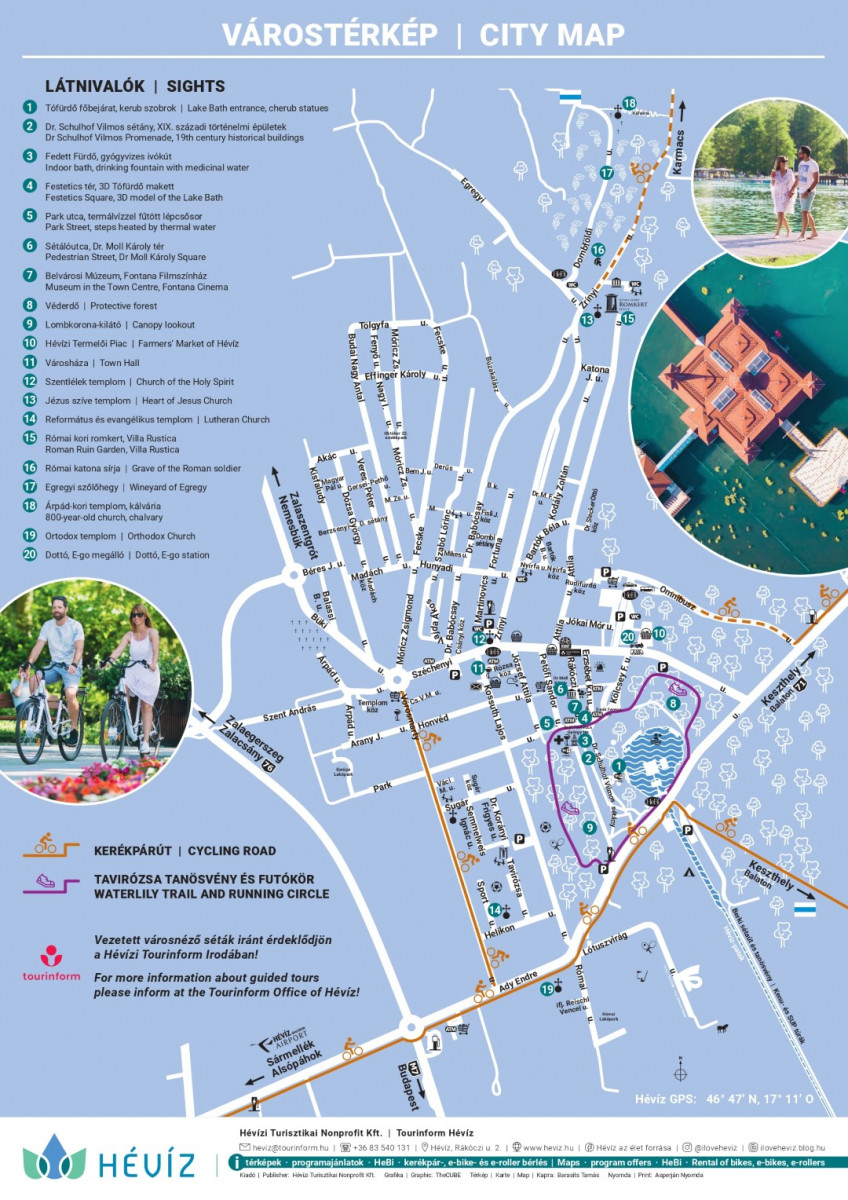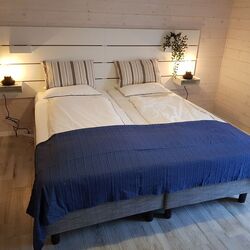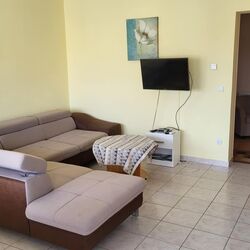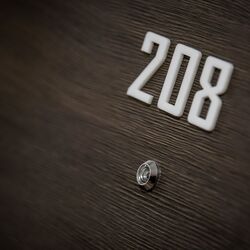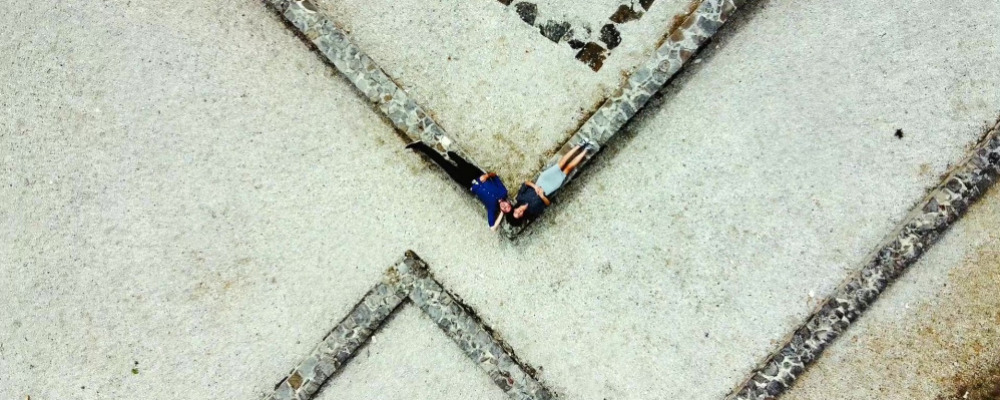
ROMAN RUIN GARDEN
Archaeological finds show that Hévíz and its surroundings were densely populated in Roman times. In 1931, the remains of a villa from the early period of the Roman empire were discovered. The villa was inhabited for almost four centuries from the first half of the 1st century to the beginning of the 5th century.
One of the most significant finds in the Balaton region is a stone building, probably a Villa Urbana, from the early period of the Roman empire excavated in the Egregy district. Built around 100 AD, the villa had a floor area of nearly 1,000 square metres, a collonaded porch, and hot, warm and cold water baths. It was rebuilt several times but survived until the early 5th century AD. The building of the villa farm or settlement, which was excavated and now to be displayed, consisted of several buildings and was rebuilt several times during its long period of use. The first "restoration" of the ruins took place in 2003 intending to present the four building periods revealed by the excavations. Since then, the excavated parts have deteriorated and the ruins have fallen into a state of disrepair necessitating restoration, which was completed in 2011.
To the west of the residential building, the remains of the farm buildings belonging to the villa were found, which may have formed a group of buildings connected to the excavated ruin. These remains show that the Romans masterfully integrated their villas and buildings into the Pannonian landscape. The villa at Egregy and the finds elsewhere in Hévíz - the Jupiter altar stone found near the lake, early imperial coins unearthed by divers - show that the "miracle lake" with its healing water may have played a role in the settlement of the Romans.
The earliest medal found here was minted by Emperor Tiberius and indicates that a 10x10 metre log house was built here with flat stones placed under the beams in the first half of the 1st century AD. Charcoal found on the stones suggests that the house burnt down, probably at the end of the 1st century.
At the turn of the 1st and 2nd centuries, a large stone building was erected on its site. It was 45 m long and almost 23 m wide, covering an area of more than 1,000 square metres. The building, with a portico on the east side, had hot, warm, and cold water baths. However, it is not certain that the building was the residential building of the Villa Urbana, as no evidence of central heating has been found.
The building was probably destroyed towards the end of the 2nd century, but was rebuilt in the 3rd century with a different internal layout, and also a sanctuary to Mithras was erected inside. The foundation stone of the altar was found during the excavation. The sanctuary and the building were destroyed in the 4th century, but the building was soon re-erected until it was finally destroyed in the early 5th century. The function of the site is uncertain in this period as well. It was probably used for some kind of economic activity.
Flavius and his nurse
The sculpture depicts the child Flavius Theodosius (reigned 379-395, last emperor of the Roman Empire) with his nurse. It is Ferenc Farkas’s work from 2015. The sculpture commemorates the Roman legend about the origin of Lake Hévíz, according to which Flavius suffered from polio. His Christian nurse wanted to cure him by all means so she prayed to the Virgin Mary every day. The Virgin, answering her prayers, caused a spring to gush forth, the medicinal waters of which healed Flavius. He grew stronger and later became the emperor of the Roman Empire. The spring has been feeding Lake Hévíz ever since.
Dry Kneipp path
In the garden of ruins, the dry Kneipp path on the outline of the unexcavated walls hidden in the ground offers tired tourists a refreshing experience. The layout of the path follows the contours of the remains of the Roman building, which was part of the villa farm. Walking barefoot on gravel, breakstone, wood surfaces and wood chips of various sizes provides a natural massage. It is very good for the circulation of the blood in the feet and strengthens the vascular walls. By massaging the reflex zones, it can stimulate all the organs, making you feel refreshed and invigorated.
Dog sculpture or The Gateway to Home
The sculpture is composed of a door of a typical Roman house and a dog. The door is made up of geometric elements, semi-open and transparent, suggesting a link between the present time and the past. The dog figure sitting in the doorway is a Great Dane, a breed already known to the Romans, dignified and aristocratic, embodying the Roman nobility, and repelling unauthorised intruders. In Pompeii, several floor mosaics survived near the entrance of houses and they depicted a watchdog in various situations. Some of these mosaics bear the inscription 'cave canem', which had the same function as the warning signs ‘Beware of dog', or ‘Bad dog'. The door is made of limestone and the dog figure is granite.
Fawn sculpture
The sculpture is a copy of a bronze figure of about 2 cm from the 4th century, which was found during excavations near Hévíz. Experts have several possible theories about the purpose of the original figure: it could have been a child's toy or a totem animal. The most likely idea is that it could have decorated a late Roman tomb. The statue was made by the sculptor Ferenc Farkas.
Roman soldier's tomb, also known as the late Roman brick tomb
The tomb is made of bricks and quicklime. It was discovered completely intact during excavations in 1925. A brick kiln was also found in the yard of a house in Egregyi Street during ploughing. The finds in the tomb date from the reign of the Roman Emperor Constantine II. A bronze belt buckle, a fibula, an iron knife, the emperor's coins and, of course, the skeleton of a Roman soldier were found in the tomb. The artefacts were taken to the Balaton Museum in Keszthely but the skeleton remained in place. On the way to the Árpád-era church, 276 Roman coins from the 4th century were also found in an earthenware jar.
Museum of Egregy
The former joiner’s workshop was renovated and converted into a museum in 2015. Between 2015 and 2020, the 282 m2 exhibition space featured a permanent exhibition under the title ‘Millennia of Hévíz’.
Eras and wines walking path
A thematic walking path in the Egregy district with boards presenting the history of viticulture and the Pannonian landscape from the Roman settlement to the Middle Ages. The Romans brought the science of viticulture with them to Pannonia, including the area around Lake Balaton, as the inscription Da Bibere (give me a drink) on a ceramic vessel found nearby testifies. Viticulture became successful because of the Romans' expertise and favourable natural conditions. The soils of Egregy are medium-textured, sandy and slightly stony. The 'warm', sometimes even 'fiery' soil, combined with the favourable climate made it possible to produce wines of excellent quality. It is no surprise that the Hungarian population living here in the Árpád era and the German settlers who arrived after the Turkish occupation continued the viticulture, which goes back to Roman roots.
The nearast Roman ruins - Fenékpuszta or Valcum
The nearest Roman ruins to Hévíz are in Fenékpuszta, in the former Roman settlement of Valcum. The settlement had a Roman military fortress, the remains of which you can walk around. You can learn more about the fortress if you visit the Balaton Museum in Keszthely.
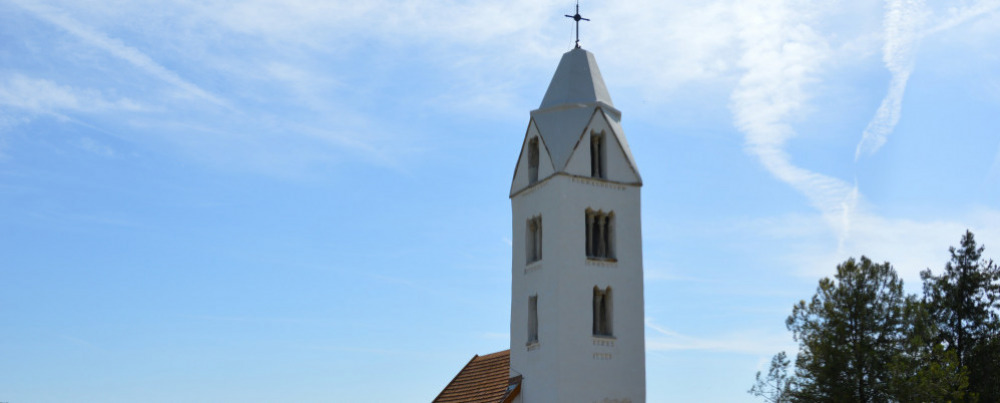
The church in Egregy is one of the three remaining Árpád-era churches in the region of Lake Balaton.
Open:
01.04. – 30.09.: 8:00 – 19:00
01.10. – 31.03.: 8:00 – 16:00
The exact date of the construction of the St Magdalene church is unknown, but it was probably built around the middle of the 13th century.
However, it is not mentioned in written records until much later, in 1341.
The first patron saint of the church was St Catherine of Alexandria. The church tower is three-storeyed, richly designed, with mullioned windows on each floor. The tower is surmounted by a Rhemish roof, which is braced by eight wooden beams. The building material of the church is sandstone, which has withstood the ravages of time. Although the church was heavily damaged in the 16th and 17th centuries, it was later renovated in the Baroque period in 1731. Fortunately, only the most essential repairs were made during the renovation, so the medieval form of the church was preserved. During the renovation, the interior and exterior decorative paintings and the nave elevation were made, and the vaults were replaced. After the reconstruction, it was rededicated and its new patron saint became Saint Magdalene.
The church has been restored several times since then: in 1860, 1912, 1964-65, 1990 and 1991, and most recently in 2015.
The church has a sanctuary with a rectangular apse, a single nave, it is oriented, the structure is easy to see, the only decorative and space-enriching element is the row of niches of the north wall. Under the tower, there is a fragment of a baptismal font from the Romanesque period and the altar is decorated with a medieval consecrated cross. It is important to mention the wall paintings of the church. They are not of medieval origin but a clear testimony to the architectural enrichment of the church and demonstrate respect for folk art. On the south side, there is an open baroque door.
The vault of the tower, joined by a rectangular nave, was restored in the 18th century. The church tower is three-storeyed, richly designed, with mullioned windows on each floor. The tower is surmounted by a Rhemish roof, which is braced by eight wooden beams. In terms of its foundations, it mainly preserved the forms of wooden architecture. On the exterior, painted decorations and incised forms have been preserved.
The church in Egregy is a particularly beautiful example of Romanesque village architecture, a specially protected historic building, which may owe its integrity and stylistic purity to the fact that the settlement was abandoned during the Turkish occupation and moved down into the valley. As a result, this church lost its religious significance and became merely a cemetery chapel.
Calvary
The length of the promenade consisting of 14 stations is about 300 meters, and the difference in level from the starting point to the cross is 23.5 meters. The calvary ascends in the direction of the Árpád-era church. Its design is characterized by simplicity and moderation. Trees offer shade in the surroundings of the walkway made of natural materials, and in some sections it is possible to rest and meditate. The materials used fits well into the landscape. The artistic works of his stations were created by Tibor Túri Török.
At the end of the Calvary, a wooden cross was added. Next to the cross there is also a stone sculpture representing an empty tomb, which symbolizes the resurrection of Christ. At the end of our walk, we come to the north side of the monument cemetery chapel, so we can also admire the small Romanesque church built in the first half of the 13th century. The calvary can be reached on foot, by bicycle, by car, and can also be visited as part of a guided walk.
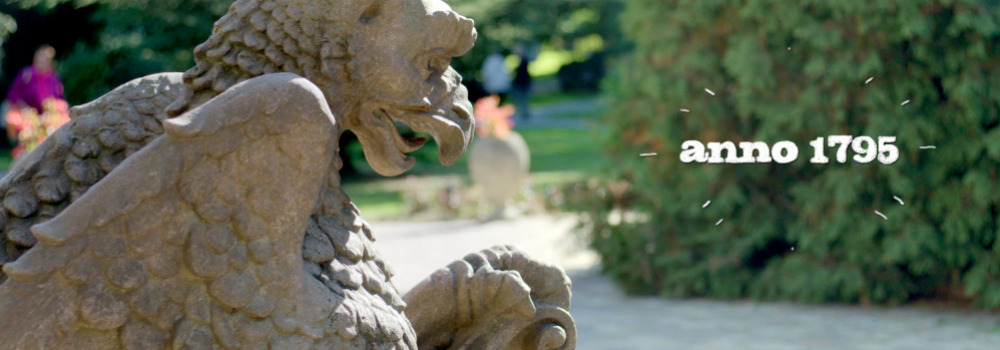
Following the Festetics family in Hévíz
The Festetics family was the most important aristocratic dynasty of Keszthely and its surroundings. The history of Hévíz is intertwined with their work at several points, so it is no coincidence that you can see works of art and buildings in several parts of the town that commemorate members of the Festetics family. Few people know that the transformation of Lake Hévíz into a spa and its development for therapeutic purposes is also owed to them.
Count György Festetics I., who was known throughout Europe and was a highly educated man, started the draining and clearing of the marsh around the lake. His work is commemorated by the square that bears his name (where the entrance to the St. Andrew's Hospital for Rheumatic Diseases is also located), as well as a life-size statue of the Count and a bronze braille table depicting the Lake Baths and their immediate surroundings.
The Lake Baths were further developed by the generations that followed him (László Festetics, then Tasziló II). Tasziló II. is also credited with, among other things, the planting of the protective forest around the lake and the creation of the forest park, which is still the "lungs" of the town and a popular recreational area. The short access road to the town through the bald cypress forest is called Festetics Alley. The Festetics Promenade runs from the southern entrance of the Lake Baths on Ady Endre Street (Festetics Bathhouse) to the promenade in the protective forest around the lake from the east.
Festetics sites in the area
Balatongyörök - Lady Mary Hamilton's resting place, Szépkilátó (lookout point)
Balatonszentgyörgy - Csillagvár (Star Castle) (exhibition, excursion point)
Cserszegtomaj - Festetics Cellar (restaurant)
Gyenesdiás - Festetics Lookout Tower (built lookout tower, excursion site)
Keszthely - Festetics Palace exhibitions (Aristocratic Lifestyle, Carriage Museum, Hunting Museum, Historical Model Railway Exhibition, Palm House, Amazon House) and Park of the Palace,
Keszthely - Balaton Museum,
Georgikon Farm Museum and Historical Exhibition Centre
Gyenesdiás - Imre Festetics Animal Park
Keszthely - Helikon Monument (Helikon Park),
Seated Statue of George Festetics (Main Square),
Our Lady of Hungary Parish Church (Festetics Crypt and epitaphs),
Festetics Mausoleum (St. Nicholas Cemetery)
Fenékpuszta - Former Festetics manor house and small mansion (currently under renovation).
Keszthely - Fenyves (Pinewood) Alley
Keszthely, Újmajor (Szendrey-telep), Júlia Szendrey Memorial Room.
Vonyarcvashegy - Festetics Helikon Tavern Restaurant, wine and gastronomy exhibition space
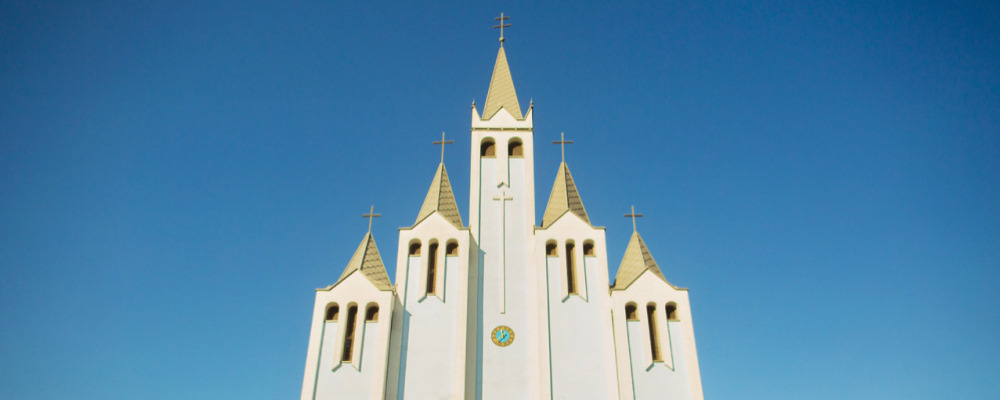
Holy Spirit Roman Catholic Church
The Roman Catholic Church of the Holy Spirit, designed by the architect János Bocskai, was completed in three years with the support of the local population.
The blue church was consecrated by Archbishop József Szendi on 9th September 1999, the day of number 9.
In front of the church, a sculpture entitled Angel by Gergely Gál stands on a 5-metre high column.
A statue of St Elisabeth of the House of Árpád by sculptor László Marton is at the entrance to the church, and a little further away on the hill are the works of Jenő Molnár, a bust of Count István Széchenyi and a bronze portrait of St Stephen in a wooden frame.
The seven towers of the church represent the seven gifts of the Holy Spirit. There are four bells in the towers, the tallest tower has no bells for static reasons. The right and left towers have two bells each. The bell on the right side was cast in honour of St. Peter from the donations of Dr Béla Horváth and his family, and the bell on the left side was cast in honour of St. Paul from the donations of Mrs Imre Varga. The two other bells were moved from the old church to the present site.
The interior of the church combines modern architecture with traditional features highlighted by the beautiful woodwork.
The church has a capacity of 1,000 people and its good acoustics make it a regular venue for organ concerts.
The stained glass windows, reminiscent of Gothic forms, were made by Endre Simon, an artist from Hévíz. The 200-year-old cross on the sanctuary wall is an art treasure and was donated to the church, and restored by restorer and painter Gyula Károlyi.
The bronze statue of Christ on the left side of the altar, and the bronze statue of the Lady of Hungarians wearing the Hungarian crown on the right side are the work of László Marton.
The fire enamel paintings on the walls were created by László Morvay.
Church of the Heart of Jesus
The Church of the Heart of Jesus was built between 1994 and 1995 according to the plans of the architect János Bocskai.
The present church is an extension of the two-storey belfry built at the beginning of the 20th century. The smaller bell of the church was cast in honour of Mary Magdalene in 1905. The third floor of the neo-Romanesque tower was added in 1937 when the community of Egregy cast the larger bell of the church in memory of the war dead of the community. The waist of the bell bears the names of the sixteen war heroes who died in the First World War. Lime trees were also planted next to the tower in their honour. In 2000, a military memorial park was created next to the church and 70 headstones were erected in the park to commemorate the fallen heroes of the First and Second World Wars.
The church, consecrated in 1995 by Brigadier General and Chaplain General Dr Gáspár Ladocsi, is also called the Fradi Church as the Ferencváros Gymnastics Club provided significant support for its construction. The close connection with the club is reflected in the white and green colours of the interior design and the small memorial corner on the right side of the entrance, where Ferencváros souvenirs are displayed. The interior woodcarvings of the church, the statue of Christ behind the altar and the Stations of the Cross adorning the wall are the work of Transylvanian woodcarvers. The paintings were completed in 1997 by a local artist, Bernadett Varga.
PROTESTANT CHURCH
For a long time, neither the Calvinists nor the Lutherans had a church in Hévíz. From the 1920s, their services were held in private houses and the Hall of Culture in the Spa Hospital or the small hall of the cinema.
In 1938, the plan of the church was created based on the design of Bálint Szeghalmi but due to inflation and the World War, it could not be built. The town council donated the current plot of land to the denominations in 1994. The architect Mihály Zoób was commissioned to update Bálint Szeghalmi's earlier design. The construction was supported by the municipality and foreign denominations. Constructed in three years, the church was consecrated in 1998 by Evangelical Bishop Dr Béla Harmati and Reformed Bishop Dr Mihály Márkus. The red stone walls and marble decoration of the church are reminiscent of the Hungarian Reformed churches in Transylvania.
The interior woodwork and the triptych made by the Kossuth and Munkácsy Prize-winning tapestry artist Rózsa Polgár are remarkable.
The bell in the tower is located under an open arch and was donated to the church by Károly Borsos and his family. The organ was completed in 2004 by Miklós Albert, an organ builder from Győr. The church is used by both the Hungarian Reformed Church and the German Evangelical Church.
Icon of the Holy Mother of God "Fountain of Life"" - Orthodox Church
The newest church in Hévíz is called the Icon of the Holy Mother of God "Fountain of Life”.
The foundation stone of the Orthodox Church was laid on 27th December 2019 by His Eminence Márk, Metropolitan of Budapest-Hungary, the Exarch of the Hungarian Diocese of the Russian Orthodox Church, and Gábor Papp, Mayor of Hévíz of that time, as well as representatives of the Hungarian Orthodox community and the Orthodox community of Hévíz-Keszthely.
The construction works started in 2020, according to plans agreed with the Municipality of Hévíz. The church, which will be 15x15 metres in size and 12 metres high, will be built in the traditional brick construction method. The masterly chamfered corners of the exterior walls of the church show the asymmetrical relief niches, a masterly combination of modern and ancient motifs. The helmeted onion dome is adorned with an eight-pointed gold-plated cross.
"
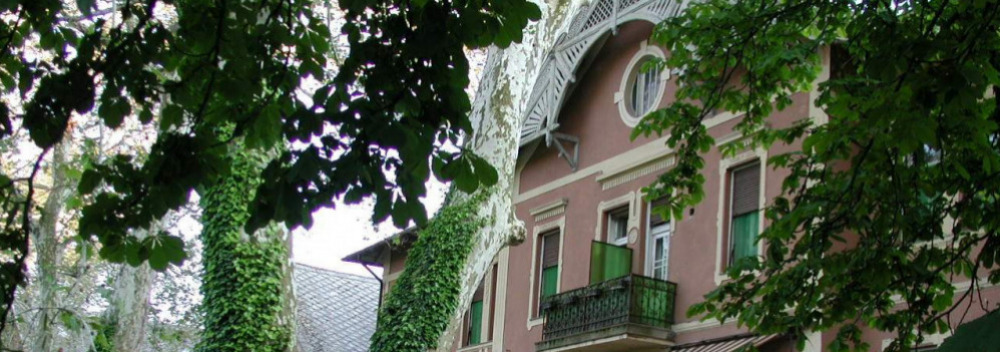
Shaded by plane trees and lined with benches, the Dr Schulhof Vilmos Promenade overlooks the lake of Hévíz on one side and the historic buildings of St Andrew’s Hospital for Rheumatic Diseases on the other. The historic buildings were built in the 1870s and were converted in the early 1900s into the two-storey houses you can see today.
House György (George)
Built in the Art Nouveau style in the northern part of the “Újtelep” (New Site) by the Festetics family. It is named after György Festetics, the founder of the spa town. It is currently Building "A" of the St. Andrew's Hospital.
House Rákóczi
The house was built in 1863 but was named House Rákóczi in 1906 in honour of the fact that the ashes of Ferenc Rákóczi II were brought home from Constantinople to Hungary in October of that year. It is currently Building “B" of the St. Andrew's Hospital.
Villa Ella
It was named after Karola Ella, the daughter of Tasziló Festetics. It is currently Building “C" of the St. Andrew's Hospital. Heading south, the next building is the restaurant and banquet hall. This building was the boundary of the Festetics estate and was the first stone house built to accommodate spa guests in the early 1860s. By 1909, a storey was added, giving it the function of a ‘Kursaal', an essential feature of the spa resort. It is now the banqueting hall of St. Andrew's Hospital for Rheumatic Diseases.
House Ferenc József
It was named after the fact that in the year of the house's inauguration, Franz Joseph - King of Hungary and Emperor of Austria - promoted Taszilo Festetics (II), the builder of the house, to the rank of prince. It is currently Building “D" of the St. Andrew's Hospital.
House Seven
The building was built in 1870-71 according to the plans of Ferenc Lonkay, the architect of the Festetics family manor. The house was part of the "Újtelep” site, where the buildings were numbered in a row, so the house kept its name. Currently, the Heviz Spa and St. Andrew's Hospital runs a hotel in the building.
House Deák
Its original name was Villa Tasziló, but after the death of Prince Tasziló Festetics (II), it was renamed House Deák after the famous politician of the era, Ferenc Deák.
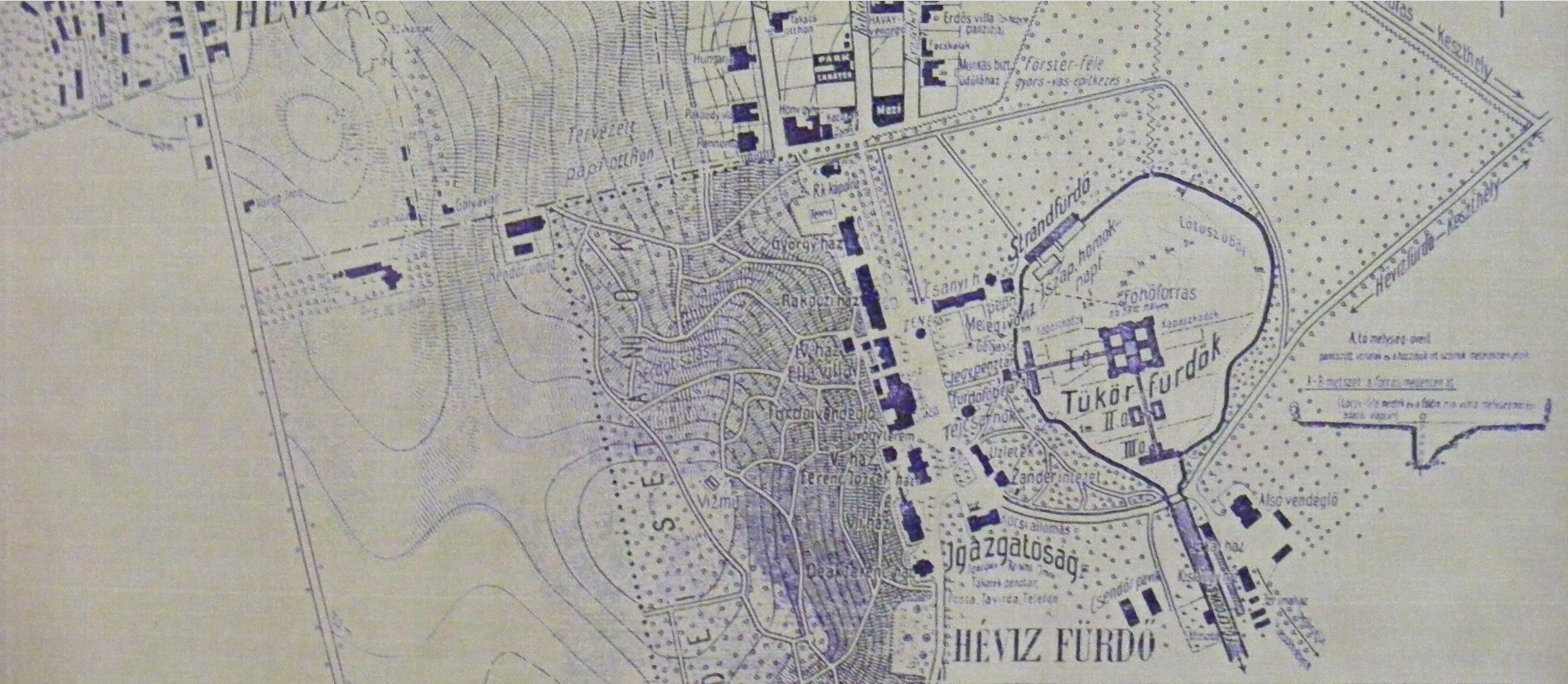
Buildings that no longer exist
The oldest and first therapeutic building by the stream was the Cupping House in the 1800s. The Jerusalem Restaurant was once located in the same area, in the “Ótelep” (Old site), and the Poor House, or the Poor Baths, was not far from the main entrance. In the early 1900s, the old cupping house changed its name to House Jókai, and behind it, the House Kisfaludy was erected. On the Schulhof Promenade, where the present management buildings of the Lake Baths are, there was already the baths management building and the carriage station. The Zander Institute was a few metres away, but there were also shops, and the Milk Hall was established almost opposite the main entrance to the lake. On the other side, soft music came from the small Music Pavilion. The former Poorhouse was then called House Csányi. On the right bank of the stream, where the mud factory stands today, there was once the gendarmerie headquarters. A tennis court and a Roman Catholic chapel stood on the site of the indoor baths. The first cinema operated on the site of the Rózsakert. And another interesting fact: the guests arriving from Keszthely did not enter the spa town through the trees of Festetics Alley where there was no road built at that time, but from today's Ady Endre Street, roughly where the promenade now leads into the park to the left of the entrance to the Festetics Bathhouse.
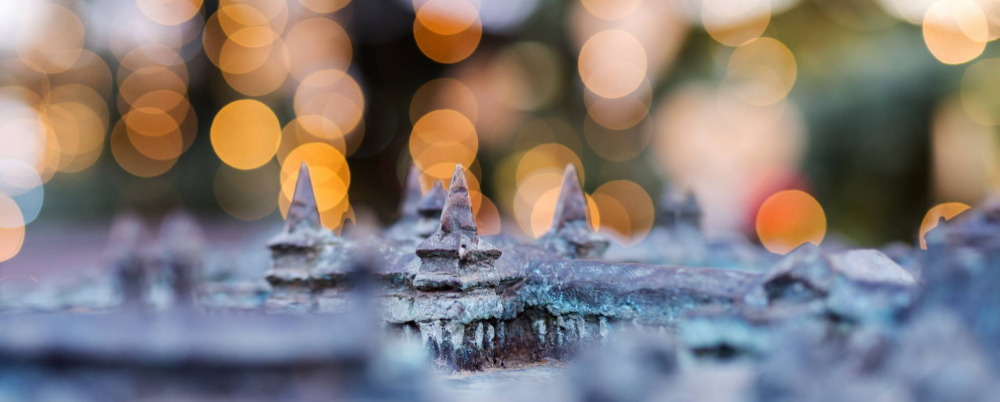
Braille map helps the visually impaired
A Braille map table was handed over in a ceremony on White Cane Day (2013. 10.15.) The map table was inaugurated on Festetics Square and was implemented by the Hévíz TDM Association with the help of a grant.
At the opening ceremony, Mayor Gábor Papp welcomed the guests.
- As a private person and as a town leader, I am convinced that it is not the only day of the year that we should pay attention to our fellow human beings who have problems, who are somehow handicapped compared to us, healthy people.
I am also in the fortunate position of being able to express my private opinion as mayor and, together with my fellow Members, to be able to pay attention to improving the situation of our disabled fellow citizens.
In Hévíz, the spa capital of the world, where the town boasts a world-famous spa lake, it could not be more different. During this term of office, I feel that we have been able to do a lot to improve the living conditions of people with disabilities. Making new buildings or those under renovation accessible to people with reduced mobility, adding braille to the premises of institutions, or painting signs to help the visually impaired to get around, are now, I believe, basic requirements. Our town has also made an effort to adapt the car parks in the town centre near the entrance to the lake for the disabled, who have the greatest difficulty in accessing the lake and the medical centre, which they need.
In the context of the restructuring of the city's transport concept, our recently awarded tender to improve public transport will also enable us to create the conditions for local public transport, which is also a major step towards improving transport for our disabled fellow citizens.
Our municipality was also pleased to support the creation of the map we are now handing over, which will be of great help to visually impaired people in finding their way around.
I hope that not only the city administration, but all our fellow citizens will approach those whose lives cannot follow their usual, healthy course for whatever reason, with empathy and a willingness to help in the future," said the Mayor in his welcome speech.
Orsolya Horváth, the president of the TDM, spoke about the background of the creation of the field table and its importance.
One of the objectives of the Hévíz TDM Association is to create services that ensure the comfort of the guests of Hévíz, and the special table for the blind and visually impaired is intended to facilitate this. The Braille map table depicts Lake Hévíz with Braille writing, so that the information displayed can be easily perceived and read by the visually impaired. A further special feature is that the artist has also worked out the lake bed and the cave source according to the real topography, making it accessible to all.
Orsolya Horváth said: the project also includes the production of a trilingual marketing brochure for the visually impaired.
Béla Molnár, President of the Association of the Blind and Visually Impaired of Zala County, spoke about the importance of the field table and its caring role.
He explained how Hévíz is exemplary in that it not only pays attention to the inhabitants of the town, but also to its guests and those who wish to recover. He believes that this place will be a wonderful experience not only for visually impaired and blind people, but for everyone who visits. He hopes that in time it will become a meeting place and will be known as "meet at the field table".
Ernő Weszely, a blind accordion player, welcomed the audience with a song by Ray Charles.
The braille tableau was made by Katalin Kalmár, a sculptor, whose most notable works in the area include the Laczkfy statue made for Keszthely and the public square sculpture of Gyula Mikus - a little boy holding a fish (Keszthely Fő tér).
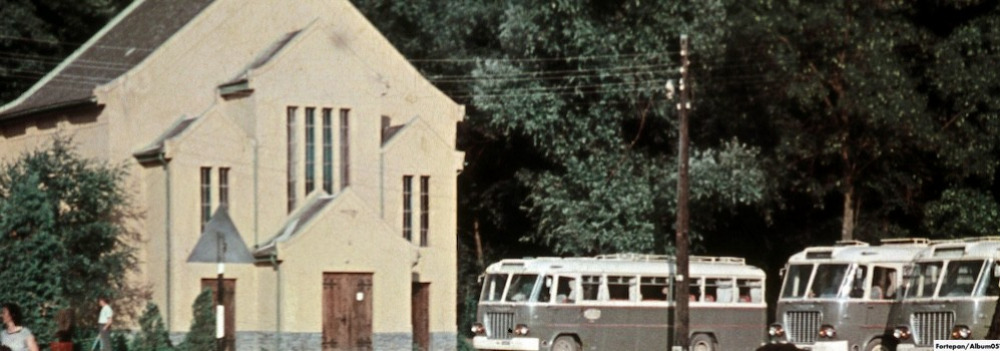
THE HISTORY OF THE JEWISH COMMUNITY IN HÉVÍZ BEFORE WORLD WAR I
Hévízfürdő, which became world-famous for its medicinal lake, was referred to as Keszthelyi-Hévíz before the First World War. On the western side of the lake, the bathing complex was established in the 1860s, which belonged to the Festetics estate. In the 1920s, the spa community was established in its neighborhood, which, together with the spa complex, belonged administratively to the Hévízszentandras district registry established in 1907. The Jews of Hévízfürdő were closely linked to the Jews of neighboring Keszthely.
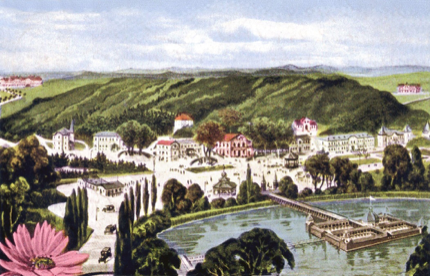
View of Hévízfürdő
Towards the end of the 18th century, the first Jewish residents settled in Hévízszentandrás (then still Szentandrás). The village's first Jew - a certain Joachim - appeared in the 1795 tax census, and the 1798 register mentioned a person named "Isák Jósef". The Jews of Szentandrás belonged to the mother faith community of Keszthely from a religious and administrative (registry) point of view.
In the second half of the 19th century, the number of Jews was limited to only a few families and only 2-3 percent of the population. In 1890, 5 out of 240 inhabitants (2.1%), in 1910 8 out of 303 inhabitants (2.6%) were of Israelite religion. Thanks to the booming spa life after the First World War, most Jews lived in Hévízszentandrás in 1930 (23 people, 3.4 percent of the population), while in Egregy, which is further from the spa, there were no Jews since the 1920s.
Among those vacationing and seeking healing at Hévízfürdő, however, the proportion of Jews became more and more significant, accounting for a quarter of the visitors (20-30 thousand people) in the summer season. The Israeli guests played an important role in the urbanization of the bathing place, in spreading the bourgeois way of life and cultural customs, while Hévízfürdő also promoted the social acceptance and practical validation of their civil equality.
Several of the hotels, shops and restaurants that spread in the spa area were owned by Jewish investors. The Jewish guests' religious needs were met by the Israelite house of prayer, inaugurated in 1910, which was built on the left bank of the drainage channel of the spa, near Ignác Lusztig's restaurant named "Jeruzsálem". During the high season - from the end of May to the end of August - dr. Sándor Büchler, The chief rabbi of Keszthely, often taught from the Bible and the Talmud. The collection of the musical services and cultural performances was used for the medical treatment of poor believers. Mandel's restaurant provided kosher meals for spa guests of the Israeli religion.
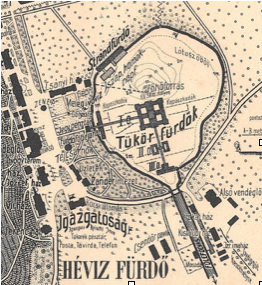
The Israelite House of Prayer stood next to the left bank of the drainage channel
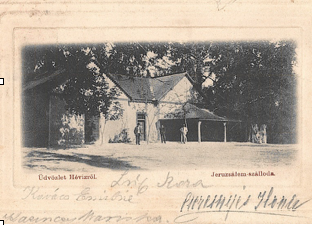
The Jerúzsálem restaurant (later Alsó restaurant)
The Reischl family, who leased the spa from the Festetics for 35 years (1905–1940), played a major role in the spa's prosperity - jr. Vencel Reischl, then Imre and Richárd's sons - as well as the Jewish spa doctors who created the foundations of Hévíz spa medicine, dr. Vilmos Schulhof and dr. Ödön Schulhof, and the Christian dr. Károly Moll.
Dr. Vilmos Schulhof, spa doctor, rheumatologist and balneologist, worked in Hévíz from 1906. Here, in 1911, he established the second Zander medical institution in Europe, where therapeutic gymnastics using machines was used as a supplement to the spa treatment. Before the First World War, spa doctor Schulhof carried out extensive scientific work to promote the spa in both domestic and foreign interest. His articles were published in numerous domestic and German trade magazines, he was one of the editors of the spa guides published annually by the National Balneology Association, in which he wrote the chapter on the Hévíz Spa. Dr. Vilmos Schulhof laid the foundations of Hévízfürdő with his research, scientific and educational work, and made the spa known abroad.
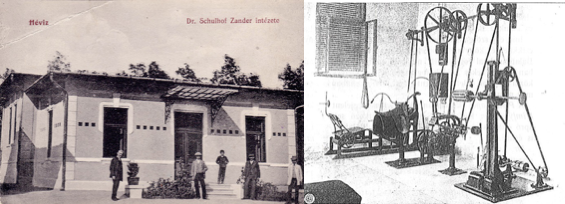
The Zander Institute and its medico mechanical machine line
THE HISTORY OF HÉVÍZ JEWISHNESS BETWEEN THE TWO WORLD WARS
By the end of the 1920s, the house of worship proved to be small, and it was far from the spa community that was developing at the "American pace". The Israelite church was inaugurated in an ornate ceremony on July 2, 1933, the ceremony was presided over by dr. Sándor Büchler, the chief rabbi of Keszthely, and it was attended by representatives of the secular authorities, many Neolog and Orthodox rabbis, as well as the spa guests. The Festetics principality contributed with real estate, the Reischl Fürdőbérlő Társaság and the Hévízszentandrás spa community, as well as numerous private individuals contributed to the construction through monetary donations. Established as a branch of the Keszthely parish and later becoming independent Dr. Sándor Büchler Chief Rabbi was elected as President of the Hévíz parish, and Dr. Adolf Kertész, a lawyer from Budapest, the organizer of the church construction and an enthusiastic supporter of the spa was elected as the secular president. Among the members of the presidium was Dr. Ödön Schulhof spa doctor, local resident Miksa Singer, and several regular visitors to the spa.
The exterior and interior of the synagogue in Hévíz followed Orthodox traditions with the aim of enabling even the more religious of the spa guests to practice their faith.
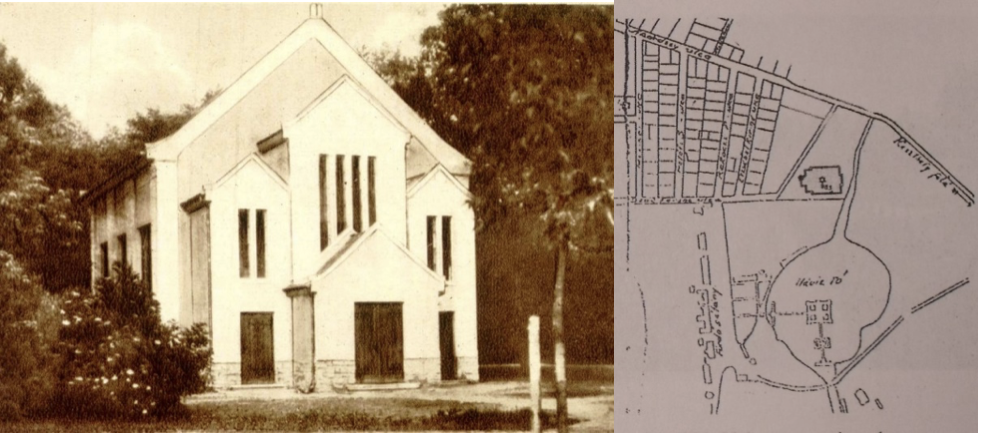
The synagogue was built in 1933 near the lake
According to reports from the time, the synagogue was crowded during the Friday evening and Saturday services with Israeli guests seeking spiritual nourishment in addition to healing, whose donations helped maintain the religious life.
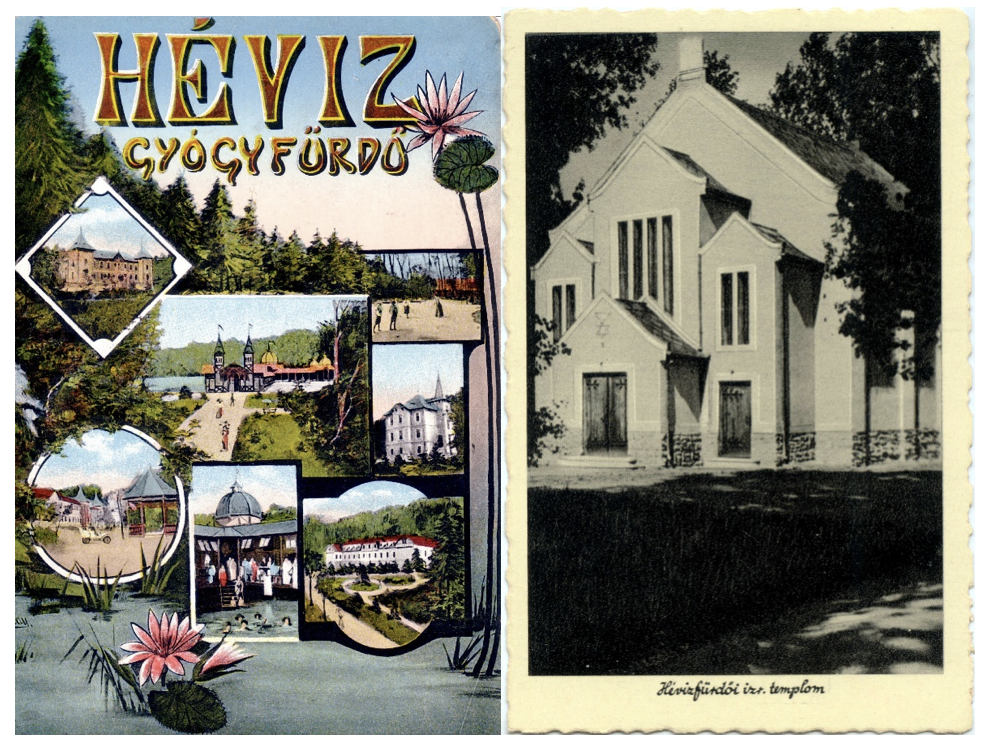
Among the vacationers, a significant proportion of people were of the Israelite religion.
In one of the buildings of the spa walkway, the Kurszalon (Medicine Room), concerts were often organized for the benefit of the Israelite church fund, in which spa guests participated regardless of denominational difference.
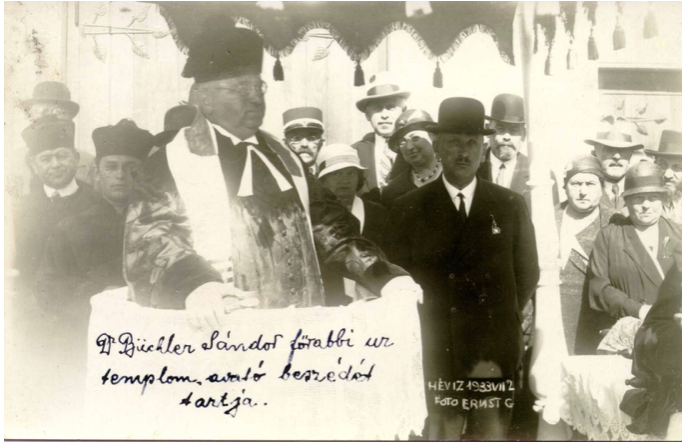
The church was inaugurated by dr. Sándor Büchler Chief Rabbi
Dr. Ödön Schulhof (Vilmos' half-brother) worked in Berlin after graduating from the medical university in Budapest, from where he returned home in 1923, and practiced at his brother Vilmos's Zander Institute in Hévíz during the spa season. His work was already considered pioneering in the decades between the two world wars. In the 1920s, he was the first to use novocaine infiltration to relieve rheumatic and joint pain. As the first X-ray doctor in Hévíz, he also produced outstanding joint and bone X-rays on a national scale. The so-called Bársony-Schulhof "view" X-ray procedure has been used all over the world.
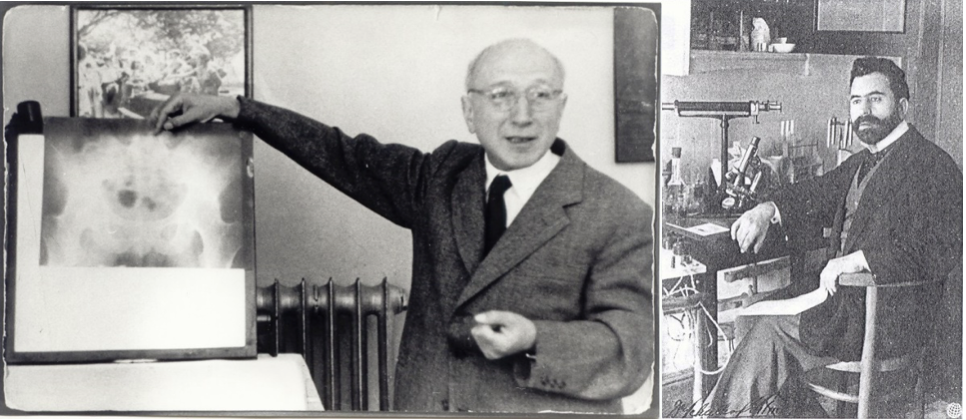
Dr. Ödön Schulhof (on the left) and Dr. Vilmos Schulhof (on the right) spa doctors
During the census of the Jewish residents of the Hévízszentandrás district registry on April 28, 1944, fifteen Jewish residents were recorded in 4 households in Hévízszentandrás and the spa area. The same number were listed in the list of names made in the Keszthely ghetto on May 26, but only thirteen were listed on the list of those transported to Zalaegerszeg due to labor service calls. Among the Jews of Hévíz, the members of the Freller, Frisch, Simon and Singer families, as well as dr. Vilmos Schulhof and László Ungár were destroyed in Auschwitz, several others (men in labor service) died elsewhere.
STARTING AGAIN AFTER THE WAR, DEMOLITION OF THE CHURCH
In the intact synagogue, Jewish spa guests visiting Hévíz continued to practice their religion after the war. However, after the death of Dr. Adolf Kertész (1959), the religious life ceased at the end of the 1960s, and the orphaned, decaying building was demolished in April 1977, in connection with the reconstruction of the buildings of the lake bath between 1977-1982.
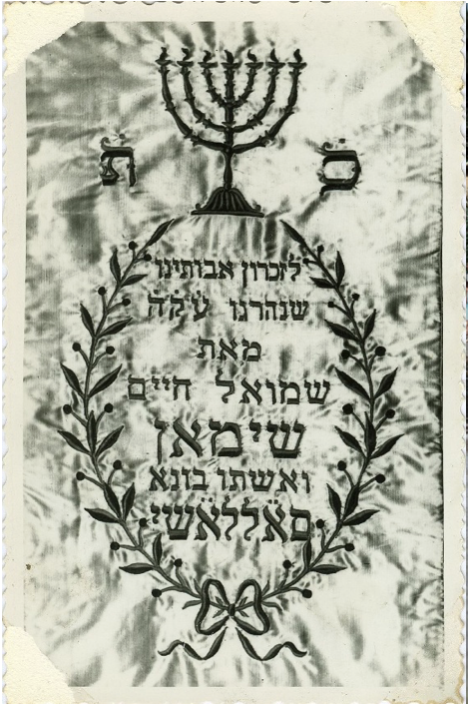
The lake cabinet cover was donated by Imre Simon in 1955
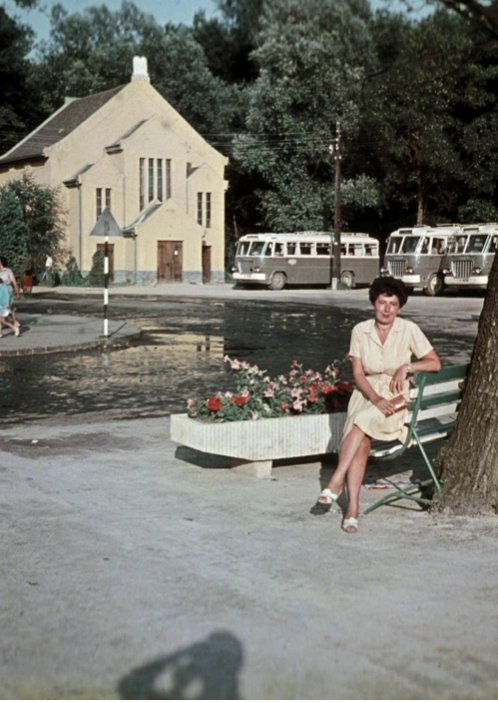
The synagogue was demolished in 1977
On July 2, 2000, the Holocaust memorial ("Hévíz Wailing Wall") was inaugurated on the site of the synagogue in the presence of the Israeli Ambassador Judith Shorer Várnai, which was built with the sacrifices of the city.
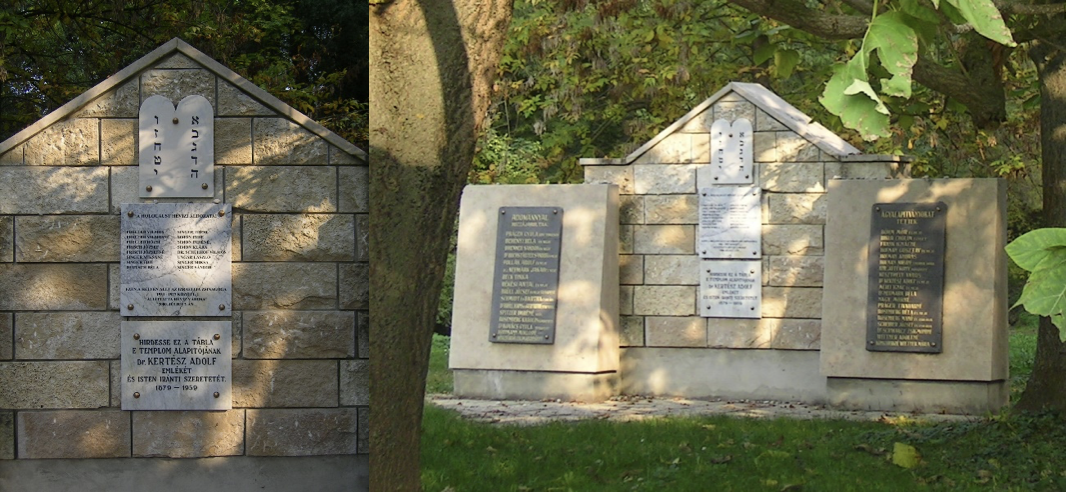
Holocaust memorial erected on the site of the synagogue
Sources used: SZARKA Lajos, Páratlan testvérpár. A Schulhof - testvérek szerepe Hévíz „világfürdővé” válásában. Hévíz: Hévíz Város Önkormányzata és Szent András Állami Reumatológiai és Rehabilitációs Kórház, 1999. első kiadás és 2002. második kiadás DR. SZARKA Lajos, A hévízi zsidóság története. Hévíz: Hévíz Város Önkormányzata, 2000.
INFORMATION FOR INTERIOR SPACE OBJECT ELEMENTS
The synagogue - or in Hebrew bet hákneszet (house of assembly) - is the central place of Jewish religious and ritual life, where Jewish people gather. The orthodox synagogue in Hévíz was inaugurated on July 2, 1933.
The main entrance and two side entrances opened from the western side of the synagogue. The women entered through the side entrance on the left, from which a staircase led up to the upstairs gallery. Women were separated from men.
The main entrance and the door on the right were used by men, the latter led to the room in the vestibule where the basin of water for ritual hand washing stood, and the faithful could enter the main entrance vestibule after this had been done.
At the inauguration of the synagogue, several commemorative plaques made of precious stones (granite, marble) were placed in the vestibule, two listed the names of those who made large donations to the construction, one indicated the time and main data of the construction (it was built between 1930-33 on the plot donated by the hg. Festetics Tasziló , at the initiative of Dr. Adolf Kertész and his wife, based on the plans of the chief technical advisor Artúr Boros, under the leadership of master builder András Varga and under the supervision of Béla Berényi). On the fourth board were the names of those who supported the Israeli patients who came to Hévíz with bed donations. The fifth - smaller - white marble tablet was erected in honor of Adolf Kertész the synagogue founder, who died in 1959.
The wooden-framed plaque of the Israelite Prayer Society of Hévízfürdő was hung in the lobby. This showed the order of services, which started on Friday at 7 pm and on Saturday at 9 am during the bathing season.
Among those listed, two large memorial plaques (donors and bed donors) and dr. Adolf Kertész's plaque was placed on the Holocaust memorial inaugurated on July 2, 2000.
In the center of the interior stood the bima, or Torah reading platform, from which the designated section of the Torah was read aloud facing east (towards Jerusalem) on Sabbaths and holidays in Orthodox synagogues. The bima was typically decorated with a menorah (seven-branched candelabrum).
In the central space - in front of and behind the bima - benches were placed, where the believers took their seats and followed the prayer.
On the east side – facing Jerusalem, the former Sanctuary – was the Torah cabinet (or frig cabinet), where the Torah scroll (or scrolls) containing the 5 books of Moses were stored. The Torah cabinet was covered with a decorative Torah cabinet cover made of velvet and silk, with embroidered Hebrew inscriptions and Jewish symbols (Star of David, menorah, olive branch), which was pulled away when the Torah was taken out. Imre Simon and his wife donated a new Torah cabinet cover to the Hévíz church in 1955, the inscription on which referred to the martyrs who were destroyed in the Holocaust ("in memory of our fathers").
Near the Torah booth, the rabbi (from the right) and the cantor, or prayer leader (from the left), had a decorative seat.
The seat of the leaders of the religious community was placed near the eastern side.
On the high-backed bench preserved from the Hévíz church, The names of President dr.Adolf Kertész, Artúr Boros and József Brüll were marked with enameled plaques.
The church was lit by 3 large windows from the north and south, and the narrower windows on the west (entrance) side were the galleries designated for women. The synagogue's small decorative glass window - depicting a blue Star of David enclosed in a white circle - has survived.
The interior lighting of the synagogue was provided by the chandelier hanging from the ceiling and the lamps placed on the walls, with bronze and wrought iron wall brackets. A wall arm from the latter also remained.
In front of the frigate, there was a perpetual candlestick (nér tómid) hanging from the ceiling, which reminds of the eternally burning fire on the altar of the Church of the Holy Sepulchre in Jerusalem. A separate association (Nér Tómid, or Örökmécs Egyesület) usually took care of keeping the candle flame alive.
HÉVÍZ SYNAGOGUE 3D RECONSTRUCTION
Hévízi zsinagóga 3D rekonstrukció
Felhasznál források:
SZARKA Lajos, Páratlan testvérpár. A Schulhof - testvérek szerepe Hévíz „világfürdővé” válásában. Hévíz: Hévíz Város Önkormányzata és Szent András Állami Reumatológiai és Rehabilitációs Kórház, 1999. első kiadás és 2002. második kiadás DR. SZARKA Lajos, A hévízi zsidóság története. Hévíz: Hévíz Város Önkormányzata, 2000.
Kép: Fortepan/Album051
Text written by: Dr. Szarka Lajos (PhD) historian.
Sources Used:
SZARKA Lajos, Páratlan testvérpár. A Schulhof - testvérek szerepe Hévíz „világfürdővé” válásában. Hévíz: Hévíz Város Önkormányzata és Szent András Állami Reumatológiai és Rehabilitációs Kórház, 1999. első kiadás és 2002. második kiadás DR. SZARKA Lajos, A hévízi zsidóság története. Hévíz: Hévíz Város Önkormányzata, 2000.
Kép: Fortepan/Album051

